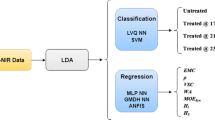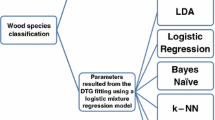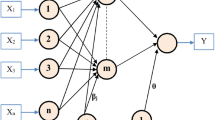Abstract
Classification of thermally modified wood is a critical assessment and control task that assures the quality of thermally treated wood. Machine learning methods can be used for identifying the optimal feature(s) for wood classification. In this study, the performance of artificial neural networks (ANN), support vector machines (SVM), and naïve Bayes (NB) classifiers for thermowood classification was evaluated and compared. The moisture content, water absorption, swelling coefficient, color, hardness, and dynamic modulus of elasticity of untreated and thermally treated western hemlock wood were measured and analyzed to identify the optimal set(s) of feature(s) for wood classification. The results showed that mechanical attributes such as dynamic modulus of elasticity obtained from the stress wave timer test and wood hardness account for the least suitable features, whereas color measurement provided an accurate classification. Both SVM and naïve Bayes model showed significantly higher performance than ANN because the latter requires a higher number of tuned and optimized parameters. Having only one feature, the accuracy of SVM and naïve Bayes model obtained from the color lightness parameter (L*) was 0.960 and 0.949, respectively. By increasing the dimension of the features, naïve Bayes model outperformed SVM and resulted in a robust classifier with an accuracy of 0.990. A trade-off between increasing the model accuracy and minimizing the number of selected features was observed. The SVM and NB models showed promising performance for the classification of thermally modified wood, which could be implemented for in-line quality control.



Similar content being viewed by others
References
Al-Aidaroos KM, Bakar AA, Othman Z (2012) Medical data classification with naive Bayes approach. Inf Technol J 11(9):1166–1174
ASTM D1037-12 (2012) Standard test methods for evaluating properties of wood-base fiber and particle panel materials. ASTM International, West Conshohocken, PA
ASTM D143-14 (2014) Standard test methods for small clear specimens of timber. ASTM International, West Conshohocken, PA
ASTM D2244-16 (2016) Standard practice for calculation of color tolerances and color differences from instrumentally measured color coordinates. ASTM International, West Conshohocken, PA
ASTM D2395-17 (2017) Standard test methods for density and specific gravity (relative density) of wood and wood-based material. ASTM International, West Conshohocken, PA
ASTM D4442-16 (2016) Standard test methods for direct moisture content measurement of wood and wood-based materials. ASTM International, West Conshohocken, PA
Avramidis S, Iliadis L, Mansfield SD (2006) Wood dielectric loss factor prediction with artificial neural networks. Wood Sci Technol 40(7):563–574
Bächle H, Zimmer B, Wegener G (2012) Classification of thermally modified wood by FT-NIR spectroscopy and SIMCA. Wood Sci Technol 46(6):1181–1192
Bedelean B, Lazarescu C, Avramidis S (2015) Predicting RF heating rate during pasteurization of green softwoods using artificial neural networks and Monte Carlo method. Wood Res 60(1):83–94
Brischke C, Welzbacher CR, Brandt K, Rapp AO (2007) Quality control of thermally modified timber: interrelationship between heat treatment intensities and CIE L* a* b* color data on homogenized wood samples. Holzforschung 61(1):19–22
Cortes C, Vapnik V (1995) Support-vector networks. Mach Learn 20(3):273–297
Dunn D (1992) A preliminary assessment of the Metriguard 239A stress wave timer. Dissertation, University of Canterbury
Esteban LG, de Palacios P, Conde M, Fernández FG, García-Iruela A, González-Alonso M (2017) Application of artificial neural networks as a predictive method to differentiate the wood of Pinus sylvestris L. and Pinus nigra Arn subsp. salzmannii (Dunal) Franco. Wood Sci Technol 51(5):1249–1258
Fan RE, Chen PH, Lin CJ (2005) Working set selection using second order information for training support vector machines. J Mach Learn Res 6:1889–1918
Fini SH, Farzaneh M, Erchiqui F (2015) Study of the elastic behaviour of wood–plastic composites at cold temperatures using artificial neural networks. Wood Sci Technol 49(4):695–705
Fletcher R (2013) Practical methods of optimization. Wiley, Hoboken. https://doi.org/10.1002/9781118723203
Forman G, Cohen I (2004) Learning from little: comparison of classifiers given little training. In: European conference on principles of data mining and knowledge discovery. Springer, Berlin, pp 161–172
Friedman J, Hastie T, Tibshirani R (2001) The elements of statistical learning. Springer series in statistics, vol 1. Springer, New York, pp 241–249
Fu Z, Avramidis S, Zhao J, Cai Y (2017) Artificial neural network modeling for predicting elastic strain of white birch disks during drying. Eur J Wood Prod 75(6):949–955
García-Iruela A, Fernández FG, Esteban LG, de Palacios P, Simón C, Arriaga F (2016) Comparison of modelling using regression techniques and an artificial neural network for obtaining the static modulus of elasticity of Pinus radiata D. Don. timber by ultrasound. Compos B Eng 96:112–118
González-Peña MM, Hale MD (2009a) Colour in thermally modified wood of beech, Norway spruce and Scots pine. Part 1: colour evolution and colour changes. Holzforschung 63(4):385–393
González-Peña MM, Hale MD (2009b) Colour in thermally modified wood of beech, Norway spruce and Scots pine. Part 2: property predictions from colour changes. Holzforschung 63(4):394–401
Hinterstoisser B, Schwanninger M, Stefke B, Stingl R, Patzelt M (2003) Surface analyses of chemically and thermally modified wood by FT-NIR. In: Acker VJ, Hill C (eds) The 1st European conference on wood modification. Proceeding of the first international conference of the European society for wood mechanics, pp. 15–20
Nasir V, Nourian S, Avramidis S, Cool J (2018a) Stress wave evaluation by accelerometer and acoustic emission sensor for thermally modified wood classification using three types of neural networks. Eur J Wood Prod. https://doi.org/10.1007/s00107-018-1373-1
Nasir V, Nourian S, Avramidis S, Cool J (2018b) Prediction of physical and mechanical properties of thermally modified wood based on color change evaluated by means of ‘group method of data handling’ (GMDH) neural network. Holzforschung. https://doi.org/10.1515/hf-2018-0146
Nisgoski S, de Oliveira AA, de Muñiz GIB (2017) Artificial neural network and SIMCA classification in some wood discrimination based on near-infrared spectra. Wood Sci Technol 51(4):929–942
Ozsahin S, Murat M (2018) Prediction of equilibrium moisture content and specific gravity of heat treated wood by artificial neural networks. Eur J Wood Prod 76(2):563–572
Palatucci M, Mitchell TM (2007) Classification in very high dimensional problems with handfuls of examples. In: European conference on principles of data mining and knowledge discovery. Springer, Berlin, pp 212–223
Pérez A, Larrañaga P, Inza I (2009) Bayesian classifiers based on kernel density estimation: flexible classifiers. Int J Approximate Reasoning 50(2):341–362
Platt JC (1999) Fast training of support vector machines using sequential minimal optimization. In: Scholkopf B, Burges CJC, Smola AJ, Press MIT (eds) Advances in kernel methods—support vector learning. MA, USA, Cambridge, pp 185–208
Schnabel T, Zimmer B, Petutschnigg AJ, Schönberger S (2007) An approach to classify thermally modified hardwoods by color. For Prod J 57(9):105–110
Schwanninger M, Hinterstoisser B, Gierlinger N, Wimmer R, Hanger J (2004) Application of Fourier transform near infrared spectroscopy (FT-NIR) to thermally modified wood. Holz Roh- Werkst 62(6):483–485
Willems W, Lykidis C, Altgen M, Clauder L (2015) Quality control methods for thermally modified wood. Holzforschung 69(7):875–884
Wu H, Avramidis S (2006) Prediction of timber kiln drying rates by neural networks. Drying Technol 24(12):1541–1545
Yang H, Cheng W, Han G (2015) Wood modification at high temperature and pressurized steam: a relational model of mechanical properties based on a neural network. BioResources 10(3):5758–5776
Zhang H (2004) The optimality of naive Bayes. AA 1(2):3
Acknowledgements
This work was partially funded by the Natural Science and Engineering Research Council of Canada (NSERC) (Grant No. RGPIN-2015-03653).
Author information
Authors and Affiliations
Corresponding author
Ethics declarations
Conflict of interest
There is no conflict of interest associated with this research.
Additional information
Publisher's Note
Springer Nature remains neutral with regard to jurisdictional claims in published maps and institutional affiliations.
Rights and permissions
About this article
Cite this article
Nasir, V., Nourian, S., Avramidis, S. et al. Classification of thermally treated wood using machine learning techniques. Wood Sci Technol 53, 275–288 (2019). https://doi.org/10.1007/s00226-018-1073-3
Received:
Published:
Issue Date:
DOI: https://doi.org/10.1007/s00226-018-1073-3




